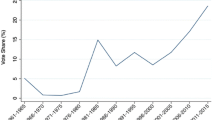Abstract
A generic system embodies basic principles and insights that are common to a set of diverse cases and situations. This paper presents a new generic system that we name the dynastic cycle structure. It is based on a stylized model of events from the Chinese history. The model describes resource allocation between social, asocial and control uses in political economies, markets and firms that experience cyclical behaviour and homeostasis symbolizing low levels of performance. Numerical simulations with the model are used to understand the internal dynamics and to test several policy scenarios.





Similar content being viewed by others
References
Bandiera O (2003). Land reform, the market for protection, and the origins of the Sicilian mafia: Theory and evidence. J Law Econ Org 19: 218–244.
Eberlein RL and Hines JH (1996). Molecules for modelers. In: Richardson G.P. and Sterman J.D. (eds). Proceedings of the 14th International Conference of the System Dynamics Society. System Dynamics Society: Cambridge, MA, pp. 149–152.
Economist (2005). The mountain man and the surgeon. 24 December, pp 24–26.
Feichtinger G, Forst CV and Piccardi C (1996). A nonlinear dynamical model for the dynastic cycle. Chaos, Solitons Fract 7: 257–269.
Feichtinger G and Novak AJ (1994). Differential game model of the dynastic cycle: 3D-canonical system with a stable limit cycle. J Opt Theory Appl 80: 407–423.
Forrester JW (1968). Market growth as influenced by capital investment. Ind. Mngt Rev 9: 83–105.
Forrester JW (1969). Urban Dynamics. Productivity Press: Cambridge, MA.
Forrester JW (1980). System dynamics—future opportunities. In: Legasto A.A., Forrester J.W. and Lyneis J.M. (eds). System Dynamics. TIMS Studies in the Management Sciences, Vol. 14. North-Holland: Amsterdam, pp. 7–21.
Gillis M, Perkins DH, Roemer M and Snodgrass DR (1996). Economics of Development. W.W. Norton and Company: New York.
Graham AK (1988). Generic models as a basis for computer-based case studies. In: Homer J.B. and Ford A. (eds). Proceedings of the 6th International Conference of the Systems Dynamics Society. System Dynamics Society: La Jolla, CA, pp. 133.
Hillier FS and Lieberman GJ (1972). Introduction to Operations Research. Holden-Day Inc.: San Francisco.
Hughes KA (2006). Justice expenditure and employment in the U.S., 2003. Bureau of Justice Statistics Bulletin NCJ 212260. http://ovc.gov/bjs/abstract/jeeus03.htm, accessed 3 October 2006.
Krugman P (1993). How I work. Am Econ 37(2): 25–31.
Lane DC (1998). Can we have confidence in generic structures? J Opl Res Soc 49: 936–947.
Lane DC (2000). Diagramming conventions in system dynamics. J Opl Res Soc 51: 241.
Lane DC and Smart C (1996). Reinterpreting ‘generic structure’: Evolution, application and limitations of a concept. Sys Dyn Rev 12: 87–120.
Meadows DL (1970). Dynamics of Commodity Production Cycles. Productivity Press: Cambridge, MA.
Miron JA and Zwiebel J (1991). Alcohol consumption during prohibition. Am Econ Rev 81: 242–247.
Miron JA and Zwiebel J (1995). The economic case against drug prohibition. J Econ Perspect 9: 175–192.
Morecroft JD, Larsen ER, Lomi A and Ginsberg A (1995). The dynamics of resource sharing: A metaphorical model. Sys Dyn Rev 11: 289–309.
Pavlov OV, Radzicki M and Saeed K (2005). Stability in a superpower-dominated global economic system. J Econ Issues 39: 491–501.
Richardson GP and Andersen DE (1980). Toward a pedagogy of system dynamics. In: Legasto A.A., Forrester J.W. and Lyneis J.M. (eds). System Dynamics. TIMS Studies in the Management Sciences Vol. 14. North-Holland: Amsterdam, pp. 91–106.
Rodzinski W (1984). The Walled Kingdom: A History of China from Antiquity to the Present. The Free Press: New York.
Saeed K (1990). Government support for economic agendas in developing countries: a behavioral model. World Dev 18: 785–801.
Saeed K (1994). Development Planning and Policy Design, A System Dynamics Approach. Avebury Books: Aldershot UK.
Sterman JD (2000). Business Dynamics. McGraw-Hill: Boston, MA.
Usher D (1989). The dynastic cycle and the stationary state. Am Econ Rev 79: 1031–1044.
Willing JK (1926). The profession of bootlegging. Ann Am Acad Pol Soc Sci 125(May): 40–48.
Wolstenholme EF (1982). System dynamics in perspective. J Opl Res Soc 33: 547–556.
Wolstenholme EF (1990). System Enquiry—A System Dynamics Approach. John Wiley: New York.
Yergin D (1992). The Prize: The Epic Quest for Oil, Money & Power. Touchstone: New York, NY.
Author information
Authors and Affiliations
Corresponding author
Rights and permissions
About this article
Cite this article
Saeed, K., Pavlov, O. Dynastic cycle: a generic structure describing resource allocation in political economies, markets and firms. J Oper Res Soc 59, 1289–1298 (2008). https://doi.org/10.1057/palgrave.jors.2602456
Received:
Accepted:
Published:
Issue Date:
DOI: https://doi.org/10.1057/palgrave.jors.2602456




